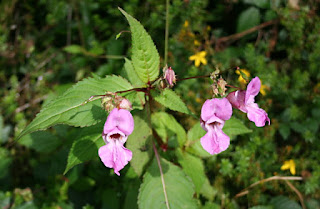At Ribble Rivers Trust we are co-delivering the Woodlands and Invasive Non-Native Species (WINNS) project as part of the Pendle Hill Landscape Partnership scheme.
The aim is to improve biodiversity and river health on and around Pendle Hill and to promote better environmental awareness around the area by creating 19 hectares of new woodlands in total, managing existing woodlands, and tackling invasive species such as Himalayan Balsam.
The aim is to improve biodiversity and river health on and around Pendle Hill and to promote better environmental awareness around the area by creating 19 hectares of new woodlands in total, managing existing woodlands, and tackling invasive species such as Himalayan Balsam.
 |
| Himalayan balsam in flower |
Himalayan Balsam control
In
particular, during this year’s gloriously long hot summer, we’ve been out in
force tackling Himalayan Balsam. For those who aren’t sure what it is, it is an
Invasive Non-Native Species (INNS) and a prize goes to anyone who can guess
where it originally came from…? You got it, they’re from the Himalayan mountain range in Asia. I’m sure you’ll agree the wonderful Victorians introduced us to some spectacular plants during the plant hunter era but they have also introduced a monster, in the invasive sense, that it can now be found almost anywhere in the UK.
It is most visible along river banks as it enjoys living in moist soil and can spread at an alarming rate due to its seed dispersing capabilities (it basically shoots its seeds out of their pods). Its roots do not penetrate far into the soil so when the Balsam dies back in winter it leaves riverbanks vulnerable to erosion as there is very little stability and no roots holding the soil together. Consequently this means that the soil may wash away.
Balsam can be tackled very easily; by holding the stem at the bottom, you
can pull it straight out of the ground as the roots are very shallow.
 |
| shallow roots and hollow stem of balsam plant |
All you
need to do then is snap the stem in two between the roots and the first node; it
has a very satisfying crunch sound! This should prevent any roots sprouting
from the nodes further up the stem. Then ideally, if you can, hang them up to
dry out over a fence, but if not you can also leave them in a pile to rot down.
 |
| Pulling up a Victorian monster! |
The optimum time to pull Balsam is between May and late July before the seed pods form and start popping.
We
worked over various sites this summer including Pendle Water in Barley,
Swanside Beck near Sawley and Raven’s Clough Wood near Brierfield. We had over
20 volunteers who spent over 120 hours of their time pulling Balsam this year
and we hope to increase these numbers in 2019!
 |
| Volunteers removing balsam at Swanside Beck |
Tree planting
This winter we will be planting over 11,000 trees to create 4 new riverside
(‘riparian’) woodlands, totalling more than 9 hectares. Not only do riparian
woodlands provide great habitat for wildlife living in and around the river, these
new woodlands will also help to connect up existing woodland and hedgerow
habitats within the area, helping wildlife to move across the landscape. Riparian
woodlands also help to reduce the amount of pollution entering the river, they reduce
the risk of flooding and riverbank erosion, and they cast shade over rivers,
preventing them from getting too hot during sunny summer days. All of this
helps to increase the health of the river and ensure it continues to function
normally, for the benefit of wildlife and people.
The winter tree planting season got off to a flying start on Sunday 2nd
December when 22 volunteers helped to plant trees in Swardean Clough as part of
National Tree Week. The team did a fantastic job, despite the wet and wild
weather, planting more than 1000 trees!
Get Involved
There will be two volunteer days each week over the winter months to
plant the remaining 10,000 trees. If you
are interested in coming along, or want to help pull Balsam next summer, then
we would love to welcome you!
To find out more you can email admin@ribbletrust.com call 01200 444452 or visit our events page on our website www.ribbletrust.com for full details and just turn up on the day 😊
To find out more you can email admin@ribbletrust.com call 01200 444452 or visit our events page on our website www.ribbletrust.com for full details and just turn up on the day 😊
 |
| WINNS sites across the Pendle Hill Landscape Partnership area, 2018-19 |


No comments:
Post a Comment